5 Magic Steps to Refresh an Old or Expired Domain
Auch verfügbar in Deutsch: 5 Schritte eine alte oder Expired Domain zu reaktivierenTable of Contents
How would refresh of an old or expired domain? #

Many SEOs may be asking themselves what’s the best way to refresh an expired domain or an older website that has been sitting there for a while with nobody creating new content or building new links.
This is a challenging question especially if you don’t have a concrete website or domain in mind. Depending on the age of the domain, history in rankings, history in link building, possible filters or penalties, topic, language, etc. that the site had, we need to take different measures, at different paces. Read on to discover some valuable general rules on how to refresh an old or expired domain.
Did you know that redirects can pass a Google Penalty?
Or that some redirects work better than others for your rankings?
1. Leave the domain as it is #
Do not touch anything.
- You need to leave the domain registration as it is, keep the same hosting, and leave the content as it is.
- You need to do an analysis of what you are trying to improve on the site.
- The first and most important question to ask is: does the website have traffic?
This leads us to the next point.
2. Review the traffic patterns on the domain #
-
Does the website have organic traffic?
-
Which keywords does it have traffic for? If the domain is just sitting there, not having traffic for any keywords or even worse, is not even indexed in Google the question is what YOUR value for that domain is? If you don’t see any organic traffic, Google might have banned this domain, and this is something you should check before you spend any time or money on it. A good idea for older domains is to check the previous content in the Internet Archive Wayback Machine or simply the Google Cache. Semrush does a great job in listing organic traffic positions in Google for various markets.
3. Review the backlink profile of the Domain #
Next thing to look at is to review the backlink structure of the website.
- Where do backlinks come from and does the website receive new backlinks on a regular basis?
- Are these links from high authority websites, relevant to your niche or are they high-risk links that may get your website penalized?
Analyse the risk for every single link #
The first thing you need to do is check if the DTOXRISK of the website’s backlink profile is high. Have a closer look at what Link Detox labels as high-risk links for your backlink profile. Link Detox (DTOX) aggregates and re-crawls link data from 24 sources and analyses every single link for you. It shows you how risky your links are and if they can get you into trouble. We recommend that you carefully review all the links that Link Detox points out as risky and choose to disavow them.
Link Detox automatically generates a disavow file for you, all you need to do is upload it to the Google Disavow Tool.
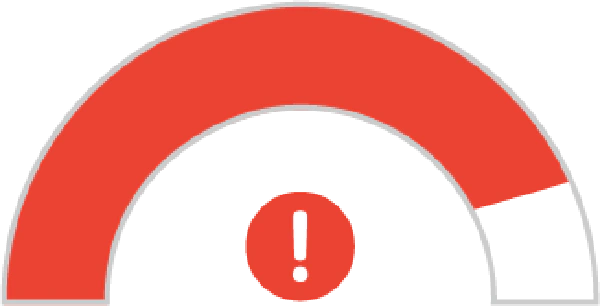
Even after you have done everything “by the book” according to Google’s recommendations and uploaded your disavow files, your website is not out of danger.
If you have a penalty, it will not be lifted.
Why? Because Google needs to crawl the URLs, you added to your disavow file.
Waiting for Google not to count all the bad links that are hurting your rankings can be a very slow and painful process. If you want to get it done faster, you can use Link Detox Boost.
It will help speed up the process of disavowed links which will result in faster website recovery. Before you decide to use the tool, wait for 48 hours after you uploaded your disavow files on Google Search Console. By using the Link Detox Boost Tool, you can be certain that Google will quickly take care of your disavow file.
We’ve witnessed Google Penalty recoveries in as little as three days from clients using Link Detox Boost. It works and clients confirm this time and again.
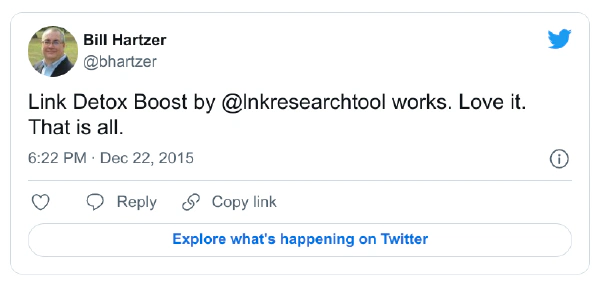
Beware of Sudden Link Drops #
If your domain suffers a sudden and dramatic link drop, the worst that can happen is that Google can devalue your website and take away your rankings. The point of leaving links intact i.e. sticking with link partnerships refers to rule number one – leave everything as it is (for the starting time at least).
Even if it costs you some time and money to keep the links that were there for years, you should stick with them until you know if these are the links you want to keep. You can monitor the changes in link growth by looking at the LinkResearchTools link velocity trend metrics (LVT).
There are positive and negative link growth trends, depending if a site wins or loses links. What is link velocity?
Link Velocity = Growth or decline of links over time.
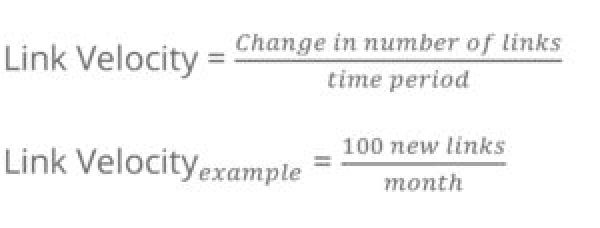
A website needs a steady link growth #
Drastic can lead to a ranking drop. Google uses link growth trends to detect any algorithm manipulation attempts. If your backlink profile grows too fast, your website could get a penalty. If you’re too slow, you won’t ever get on the first page.
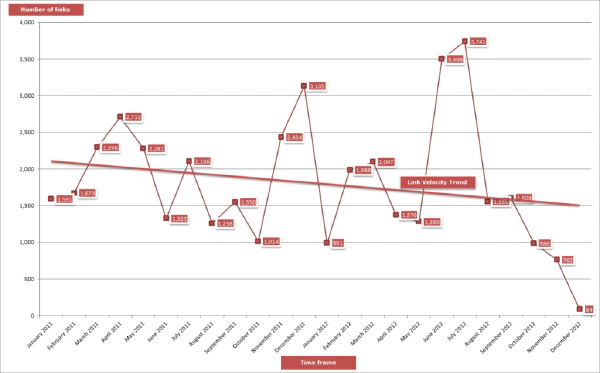
With a LinkResearchTools Superhero account or a higher subscription, you can analyze and monitor link velocity trends in great detail and compare your link profile to the ones of your competitors.
You want to make sure that you don’t stand out with either building many more links than your competitors.
5 Magic Steps to Refresh an Old or Expired Domain
You can check the link profile of any website using LinkResearchTools.
It’s an awesome time saver and helps give you a high-level view of any domain and compare those against other own or competitor domains
4. Slowly build links and content #
There’s not a magic number of links per month that are OK for everyone. This could be one or one thousand – depending on your industry, language, and competition.
Doing a competitive research needs to be the starting point for ANY SEO project. Either you do it yourself or hire someone else to do it – but you HAVE to understand the market you’re in.
That’s why doing an upfront analysis and then starting out slow is what we also recommend to all our new clients. It’s tough to manage (your own) expectations if you don’t know what you should aim for. Goals like “Top 3 position for all keywords for xxx EUR /month” are only very high-level dreams but not the basis for the planning of an SEO and link building a campaign if you have no idea where your competition stands.
Start your link development plan #
Slowly start to build links and add content. Let’s assume that you have an average size website with only a few hundred links. Then adding a few links a day or a week is just sufficient for you to test how the website responds to new links and new content. You should see some changes in traffic and rankings over the weeks for those keywords you linked and possibly other phrases as well (depending on the trust of links you got). This is what happens to healthy sites. But you have to give it time. Don’t expect results after days if you haven’t done anything for years. But after 2 or 3 months we know that this is a healthy domain, and we can maybe increase the pace. Add more content, add more pages and build links around the keywords you already rank for.
To sum up: the idea here is to follow up with what Google already gives you credit = rankings. Take that and build upon it!
5. Don’t lose link power and trust #
We’ve seen a LOT of sites that lose link power and trust because of poor server maintenance and poor On-Page SEO. When you’re trying to improve the rankings of an old or expired domain, try to find out if there are any powerful broken links on your domain and try to fix them.
The Link Recover Tool (LJR) helps you find out which links are going to the site that does not have any corresponding page. This fact means a 100% loss in link power and trust. Every link that ends in a 404 error or another error page is a lost link.
If you find that a website has that problem (and it only takes a couple of minutes with the Link Recover Tool), you have to fix that by implementing SEO-friendly redirects for the missing pages. The Link Recover Tool generates those redirect rules for you. All you have to do is take this output, make sure that you have appropriate targets for your links and fill it in your Apache Web Server Config. Then wait for a couple of days to see how those links you missed before improved your website’s traffic. When you implement redirects, you must make sure that you get it right. Not all redirects pass link power and trust, or some may do that more than the others.
Think twice when you make redirects, some may pass Google Penalties #
For example, 302 redirects pass ranking and pass also penalties.
Redirects pass link penalties since 2013.
In the past, there was this SEO trick that you could redirect a domain and get all the positive link juice, all the benefits while leaving the penalties behind. All that changed in 2013 with the Penguin 2.0.
Since then all kinds of satellite domains or domains you bought for SEO and redirected in the past may have passed on penalties. Your site may have good links, but those redirected may pass a penalty.
You need to run a Link Detox for each redirected domain.
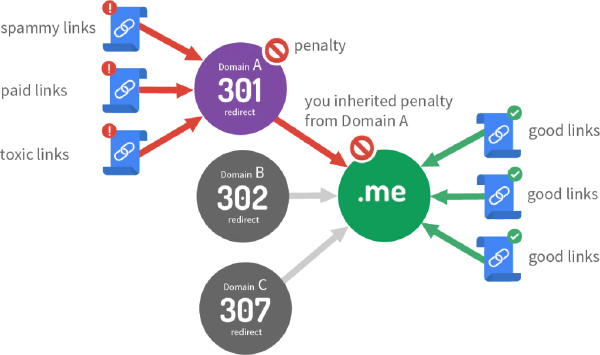
The German retailer, Home24 suffered a dramatic traffic drop caused by redirects that passed a link penalty to them.
You can read more about the Home24 Penguin penalty in our SEO case studies.
5 Magic Steps to Refresh an Old or Expired Domain
You can use the Link Redirect Trace Extension to check your website’s links and redirects every day.
It helps you discover On-page and Off-page SEO issues, detect a Google penalty and so much more.
Read more about the Link Redirect Trace Browser Extension and download it for your browser.
It’s important to setup redirects for strong pages you have on abandoned domains or domains that you bought from someone else. Any expired domain that you could get hold of has that problem (or it’s you having the problem not knowing the previous website structure precisely). By fixing the redirects for missing pages and recovering the link power and trust from links that you forgot about the first push to the site could already happen. Google will then figure out that somebody takes care of the site. We often compare Google to a human: give them the good feeling that you care about your site again they will give you credit and try to help you with better rankings.
Monitor traffic and rankings – then repeat! #
- Continue building links
- Continue adding content
- Monitor the traffic and the rankings, then repeat
After you see the first signs of success, go back to the link audit step and start from that point again. SEO and site development is an ongoing process.
The cycle never ends. You add content and new links and see what happens. If the domain is healthy and if you took care of all the links and recovered the good ones it already had then you should see an increase in traffic and rankings. If you do that for a couple of months, you will have a nice, strong and healthy website that you can monetize. But be careful: do not place ads on every corner; do not try to sell links on it after the second week or something like that because this is just a waste of time. Try to create better content for the visitors. If you start to attract links naturally, apart from the strong links you build, then you are a winner. Again we are talking about weeks and months, not days here. The more time you will give it, the better you will benefit from it. You had it sitting there for one or two years so you should be prepared to let it sit around for another year to make it strong if you decide to build it out.
Repeat, Repeat, Repeat – Stick with it! #
Again it is all about repeating the whole process of adding new content, adding links to the website and monitoring the impact of the links and finally reaping the benefits. We sure hope that you enjoyed this article on how to refresh an old or expired domain.


